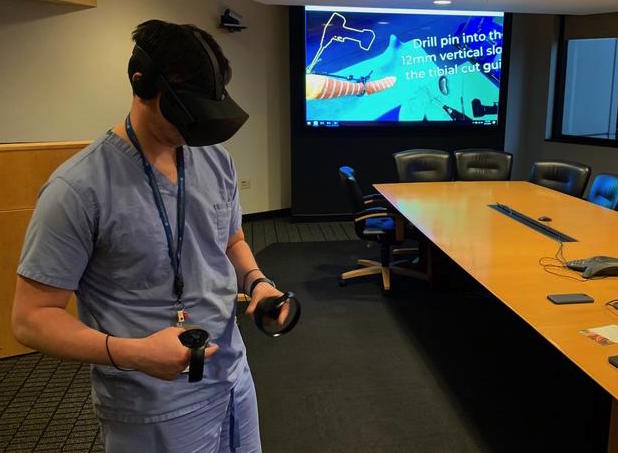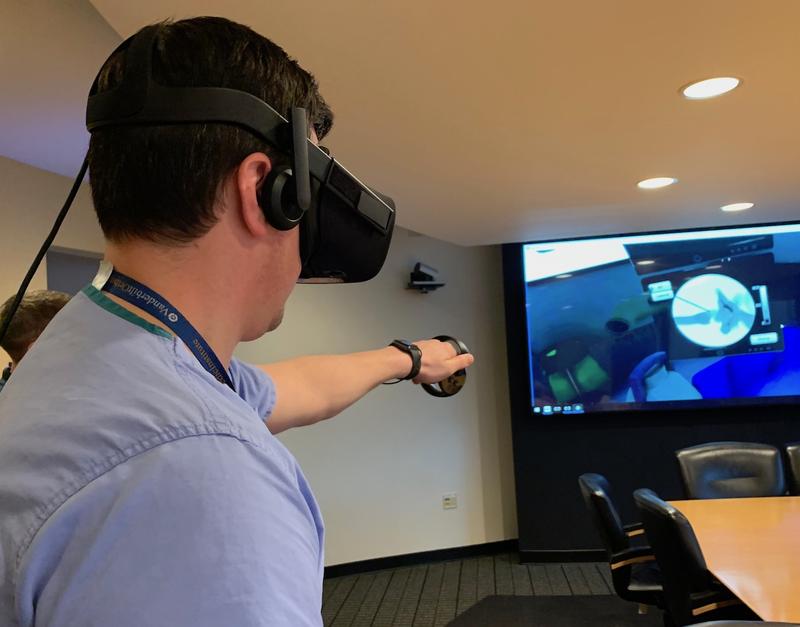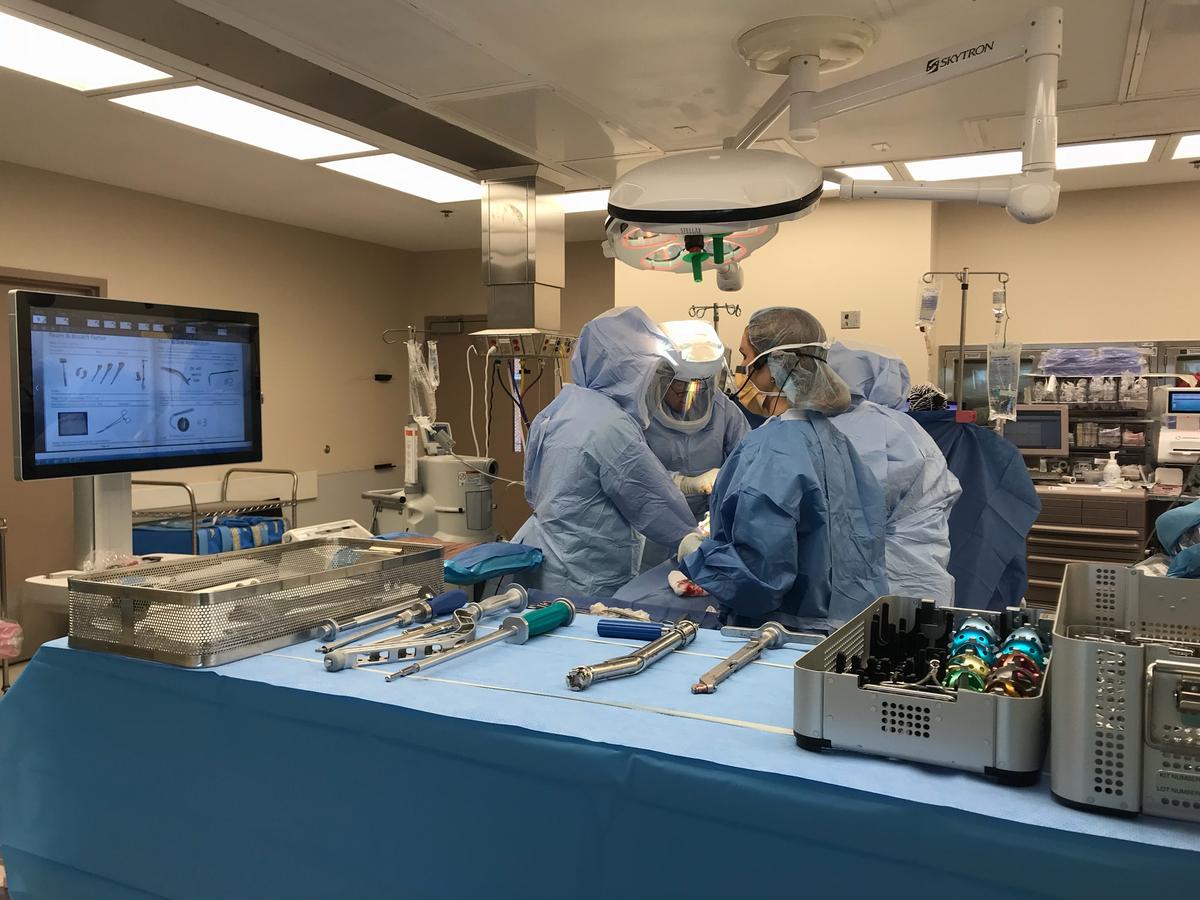
Imagine a surgeon scouring the web for how-to videos during a complex procedure. It happens, especially in the ever-evolving and rapidly growing world of implantable medical devices.
So now, a virtual reality system is trying to help surgeons prepare to use all the new equipment available to them.
“I’ve been in many of these surgeries myself, and it’s pretty similar each time,” says Justin Barad, a pediatric orthopedic surgeon and founder of Osso VR. “What happens is you get stuck pretty quickly, you don’t know what to do or something goes horribly wrong, and you start frantically asking either an assistant to scrub out and Google YouTube videos or instruction manuals.”
The latest artificial hips or spinal rod systems also require dozens of steps and come with hundreds of tools to account for varying body sizes and complications. That’s one reason medical device makers like to have a person in the surgical suite to offer guidance,
often from the back wall with a laser pointer.
“There’s usually a sales rep in the room who is trying to get you through the case and knows how to do it better than you do,” Barad says.
More:
Salesmen May Be Wearing Out Their Welcome In The Operating Room
So Osso VR’s virtual training is trying to solve a systemic issue in the largely informal system for getting implantable medical devices from a manufacturer to inside a patient’s body.
Barad argues many device malfunctions brought to light in recent years are less about the product and more about the performance of the surgeon.
“When they do have problems in patients, it’s often related to longer learning curves that were unanticipated or that people didn’t know how to use them well enough,” he says.
But as the medical device industry tries to find ways to educate surgeons and their assistants through technology like virtual reality, companies also hope to promote sales of their newest products.
Virtual Surgery Product Placement
J.P. Wanner, this third-year orthopedic surgical resident at Vanderbilt University, straps on a pair of VR goggles. Instantly, he’s immersed in an operating room, explaining each step of the surgery as his professor, Jon Schoenecker, observes.
Wanner is practicing a fairly rare procedure, using a special pin to repair the dislocated hip of a child. It’s known as a ”
skiffy.”
“I’ve seen and operated probably twice on an actual skiffy,” he says.

He grabs specialized tools from a stack of trays laid out on the virtual table. The commands float in the replica of an operating room, guiding him from one step to the next.
He drills a pilot hole and selects the correct size pin to place through the bone. But the angle is a little off. He grouses about his less-than-perfect score.
“I’m not happy with that,” he says. “I want to do it right now, again.”
The opportunity for repetition is why his teacher sees huge educational potential in virtual reality, where the user is allowed to make mistakes.
“But if I’m in the operating room, my gosh, I don’t want to let him do that,” Schoenecker says.
Vanderbilt and a dozen other academic medical centers, including at Brown and UCLA, are test piloting the virtual reality system from Osso VR.
For years, virtual reality has been
too expensive for surgical practices or even many schools to want to pay for. But they won’t be paying for the platform — at least, not directly.
It’s the makers of implantable medical devices who will front the cost to have their products featured in a virtual world. In turn, those companies hope the users will choose their products when working with patients.
Smith & Nephew, one of the largest device makers in the U.S., announced a
deal with Osso VR in March to showcase its newest artificial knee system, which includes robotic assistance for the surgeon.
Beyond VR
Virtual surgery isn’t the only innovation trying to address the medical device education gap. One Louisiana-based company, Sight Medical, works with device makers to produce step-by-step manuals displayed on large screens inside the operating room. That way, the company doesn’t necessarily need a sales rep to be on hand to answer questions.
Orthopedic surgeon Vinod Dasa, a professor at Lousiana State University and the company’s medical director, says the technology is not a cheat-sheet but more akin to GPS for drivers.
“You know how to drive your car, but the GPS really allows you to drive your car from point A to point B as efficiently as possible. So that’s what this is allowing everybody to do. It’s elevating the game,” he says. “As I get better, the patient’s outcomes get better.”

Sight Medical’s technology also handles logistics for getting the devices to the hospitals, something that usually falls to sales reps. Ochsner Health Systems, based in New Orleans, is
testing the new model.
But these solutions still have problems, says Lisa McGiffert with the Patient Safety Action Network. She says the innovations fail to distance hospitals and surgeons from the influence of device makers.
“It can lead to more dependency on the company for information than even a sales rep might create,” she says.
McGiffert says medical device companies have shown they can’t entirely be trusted when it comes to disclosing flaws in their ever-expanding array of implantable devices.
“Surgeons might not need all those choices,” she says. “They need choices that work effectively. And they need choices that are safe for patients.”
More:
Tennessee And 45 Other States Win $120M For Defective Hip Implants
Arguing For The Win-Win
But device makers live or die based on innovation. And all the new products require training.
Often, device makers fly surgeons in to a company lab for face-to-face sessions about new hardware. Even then, it’s difficult to judge whether they’ve really achieved mastery. So companies are intrigued by alternatives like virtual reality that are portable and provide objective grading based on performance.
“We can bring the training right to them. They can safely make mistakes and learn and repeat until you’ve pretty well got the steps mastered,” says Tim Mauri, director of professional education at Johnson & Johnson.
The big medical device makers have entire divisions dedicated to educating surgeons. And they argue training has become the primary role of the sales rep, instead of selling.
Mauri says everyone benefits from having educated surgeons.
“Our best customers are ones who are happily using our products, meaning that they’re feeling very confident and comfortable with them in their hands,” he says. “The better for them and the better for us as well.”


